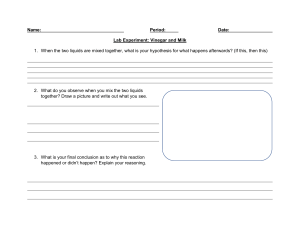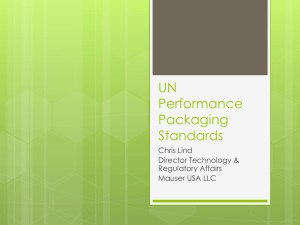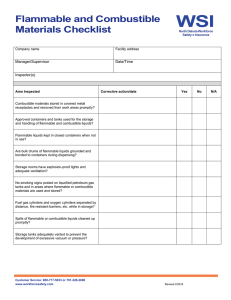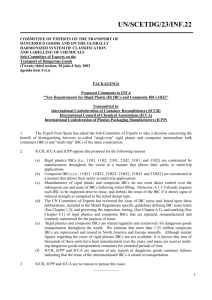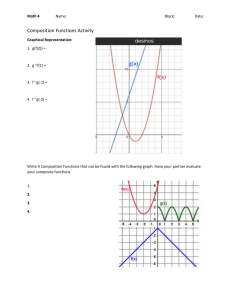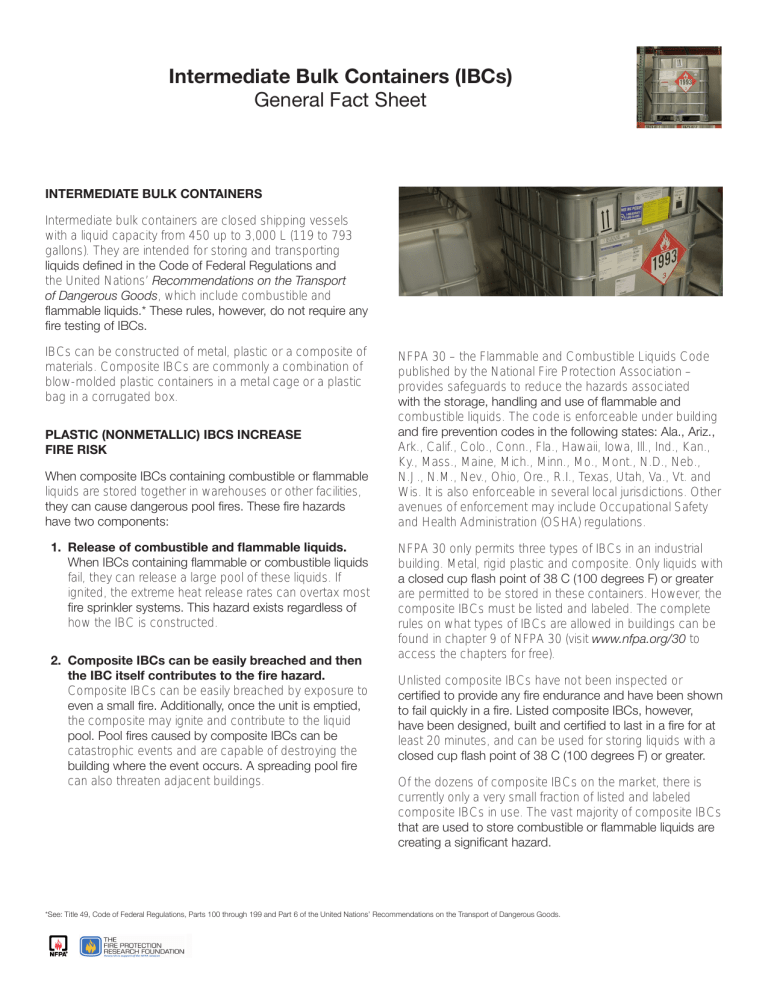
Intermediate Bulk Containers (IBCs) General Fact Sheet INTERMEDIATE BULK CONTAINERS Intermediate bulk containers are closed shipping vessels with a liquid capacity from 450 up to 3,000 L (119 to 793 gallons). They are intended for storing and transporting liquids defined in the Code of Federal Regulations and the United Nations’ Recommendations on the Transport of Dangerous Goods, which include combustible and flammable liquids.* These rules, however, do not require any fire testing of IBCs. IBCs can be constructed of metal, plastic or a composite of materials. Composite IBCs are commonly a combination of blow-molded plastic containers in a metal cage or a plastic bag in a corrugated box. PLASTIC (NONMETALLIC) IBCS INCREASE FIRE RISK When composite IBCs containing combustible or flammable liquids are stored together in warehouses or other facilities, they can cause dangerous pool fires. These fire hazards have two components: 1. Release of combustible and flammable liquids. When IBCs containing flammable or combustible liquids fail, they can release a large pool of these liquids. If ignited, the extreme heat release rates can overtax most fire sprinkler systems. This hazard exists regardless of how the IBC is constructed. 2. Composite IBCs can be easily breached and then the IBC itself contributes to the fire hazard. Composite IBCs can be easily breached by exposure to even a small fire. Additionally, once the unit is emptied, the composite may ignite and contribute to the liquid pool. Pool fires caused by composite IBCs can be catastrophic events and are capable of destroying the building where the event occurs. A spreading pool fire can also threaten adjacent buildings. NFPA 30 RULES REDUCE THE RISK NFPA 30 – the Flammable and Combustible Liquids Code published by the National Fire Protection Association – provides safeguards to reduce the hazards associated with the storage, handling and use of flammable and combustible liquids. The code is enforceable under building and fire prevention codes in the following states: Ala., Ariz., Ark., Calif., Colo., Conn., Fla., Hawaii, Iowa, Ill., Ind., Kan., Ky., Mass., Maine, Mich., Minn., Mo., Mont., N.D., Neb., N.J., N.M., Nev., Ohio, Ore., R.I., Texas, Utah, Va., Vt. and Wis. It is also enforceable in several local jurisdictions. Other avenues of enforcement may include Occupational Safety and Health Administration (OSHA) regulations. NFPA 30 only permits three types of IBCs in an industrial building. Metal, rigid plastic and composite. Only liquids with a closed cup flash point of 38 C (100 degrees F) or greater are permitted to be stored in these containers. However, the composite IBCs must be listed and labeled. The complete rules on what types of IBCs are allowed in buildings can be found in chapter 9 of NFPA 30 (visit www.nfpa.org/30 to access the chapters for free). Unlisted composite IBCs have not been inspected or certified to provide any fire endurance and have been shown to fail quickly in a fire. Listed composite IBCs, however, have been designed, built and certified to last in a fire for at least 20 minutes, and can be used for storing liquids with a closed cup flash point of 38 C (100 degrees F) or greater. Of the dozens of composite IBCs on the market, there is currently only a very small fraction of listed and labeled composite IBCs in use. The vast majority of composite IBCs that are used to store combustible or flammable liquids are creating a significant hazard. *See: Title 49, Code of Federal Regulations, Parts 100 through 199 and Part 6 of the United Nations’ Recommendations on the Transport of Dangerous Goods. Sponsored by the Fire Protection Research Foundation and Property Insurance Research Group 1 MISUNDERSTOOD RULES CREATE LIMITED COMPLIANCE U.S. Department of Transportation (DOT) and United Nations regulations permit the shipping of combustible liquids and some flammable liquids in many types of IBCs. However, transportation regulations do not require IBCs to be fire tested and DOT has no jurisdiction over commodities in storage. Yet, many producers and customers alike believe that a shipping container approved by DOT is also approved for storage in a warehouse. This is not the case. NFPA 30 rules limit the types of IBCs allowed in buildings and also set limits on the liquid types permitted in them. Generally, flammable liquids (flash point below 38 C or 100 degrees F) should never be placed in a plastic IBC of any type, listed or unlisted. Combustible liquids should never be placed in an unlisted plastic IBC. Additionally, in some cases, other fire properties, such as fire point, may also govern storage requirements. Those responsible for the storage of combustible and flammable liquids should always look beyond the flash point and also assess the chemical composition of the liquids contained in the IBC to better assess the fire risk posed. Additionally, warehouse or facility personnel responsible for accepting or storing goods are often unaware of the serious fire hazard created by composite IBCs containing combustible and flammable liquids. As a result, improper storage and potentially dangerous conditions often go unrecognized. FOUR STEPS TO RECOGNIZE THE RISK AND COMPLY WITH NFPA 30 One: Determine whether the IBC is in or will eventually enter a protected facility. A protected facility is defined in NFPA 30. Requirements include, but are not limited to, increased levels of sprinklers or other protections, depending on the hazards to be protected against. Two: Identify the liquids to be stored. Determine if liquids stored or being received are NFPA 30 Class I (flammable – flash point 100 F), NFPA 30 Class II (combustible – flash point 100 F up to 140 F) or Class III (combustible – flash point 140 F and higher). Three: Identify the IBC material. Identify if the IBC is metal, plastic or composite, and if the latter, if it is listed and labeled. Four: Determine if the IBC material is appropriate for storage of its contents in the protected facility. Determine if any of the Class I liquids are stored or being received in composite IBCs. If so, switch to metal IBCs. Determine if any of the Class II or Class III liquids are stored or being received in unlisted IBCs. If so, you can comply with NFPA 30 by switching to listed composite or metal IBCs. REDUCE THE RISK BY MAKING A COMMITMENT TO SAFE STORAGE The Fire Protection Research Foundation with funding from the Property Insurance Research Group in coordination with NFPA and the insurance industry are working together on an awareness campaign to help reduce the risk created by improper storage of IBCs containing combustible or flammable liquids. This effort includes the following activities: • Educate impacted groups – container manufacturers, chemical manufacturers, code and fire officials, warehouse owners, managers and staff, insurance representatives, procurement and supply chain specialists, risk managers and fire fighters – on what they can do to ensure safe storage. • Encourage those responsible for storage of combustible and flammable liquids to: 1. Check their facilities, operations and procedures for NFPA 30 compliance. 2. Correct any composite IBC hazards. Everyone can help reduce this risk by following steps at www.nfpa.org/ibc to make a commitment to safe storage. Here you can learn more about the issue and find tailored information for container manufacturers, chemical manufacturers, code and fire officials, warehouse owners, managers and staff, insurance representatives, procurement and supply chain specialists, risk managers and fire fighters. Sponsored by the Fire Protection Research Foundation and Property Insurance Research Group 2

